New road project transforms lives
Before the project, it would take over six hours to complete a 133.9km-distance from Sembabule to Mpigi before connecting to Masaka-Kampala highway.
Aerial view of the complete Sembabule-Kanoni highway. Photos by Davis Buyondo
ROAD MADDU TRANSPORT MASAKA
About five years ago, a road connecting the four districts of Mpigi, Gomba, Sembabule, and Masaka was in bad shape. It was bumpy and dusty in the dry season and slippery when it rained.
Any traveler would always find stuck vehicles on the road. They would be carrying merchandise, livestock (cows, sheep, goats, and pigs), milk and agricultural produces, stuck in huge potholes for hours and days.
Other vehicles would break down or fail to maneuver slippery sections causing enormous delays for the goods and services. It took travelers, traders, transporters, and motorists plying the route quite several hours to reach the main highways, towns, and markets respectively. And roadside businesses had deserted the route due to dust.
In a bid to redeem the road users and residents of the plight, the Government through the Uganda National Roads Authority (UNRA) apportioned sh360b to tarmac the road to interconnect the four districts.

A truck on a yet to be completed portion of the road in Sembabule
In 2016, UNRA contracted Energoprojekt and China Railway No.3 Engineering Group Co. Ltd (CR3) to construct the road. Energoprojekt constructed 64km Mpigi to Kanoni in Gomba district and CR3 took up the 110km-section from Kanoni through Sembabule up to Villa Maria in Masaka.
Mpigi-Kanoni section is complete while Kanoni-Sembabule-Villa Maria is nearly complete with a few sections left (especially within Sembabule town and Villa Maria).
However, the once poor and unlikable road/route has become a major highway and transformed lives in the four districts in various ways including easing transportation, stimulating economic activities for development as detailed below.
Travel time and space
Even when petrol prices went up and pushed transport fares up countrywide, the transporters and road users plying the highway appreciate the swiftness and convenience on the road.
According to Leonard Kazungu, a commuter taxi driver plying the Sembabule-Kanoni-Mpigi-Kampala route, the road dwarfed space and travel time in addition to the transport fares.
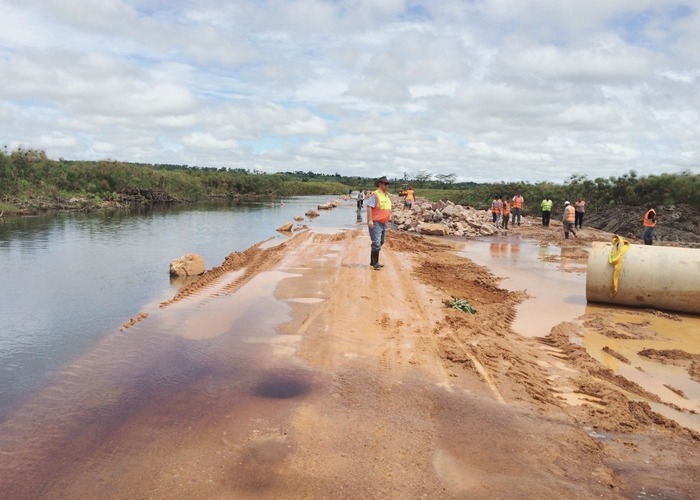
Construction in progress at Kyogya swamp junction in the project's initial stages in 2016
Before the project, he recounts, it would take him over six hours to complete a 133.9km-distance from Sembabule to Mpigi before connecting to Masaka-Kampala highway.
"I could only make one trip then return the following day. Even passengers were hesitant to travel the route by sundown," he says.
The Government had announced plans to tarmac the road from end to end (Mpigi-Masaka) in 2010, but the project delayed for five more years, which drained Kazungu's hopes and a few commuter taxi operators then.
"But as soon as the project rolled our operations, I was relieved because mere expansion before tarmacking had made it easy for us to speed up, and move," he adds.
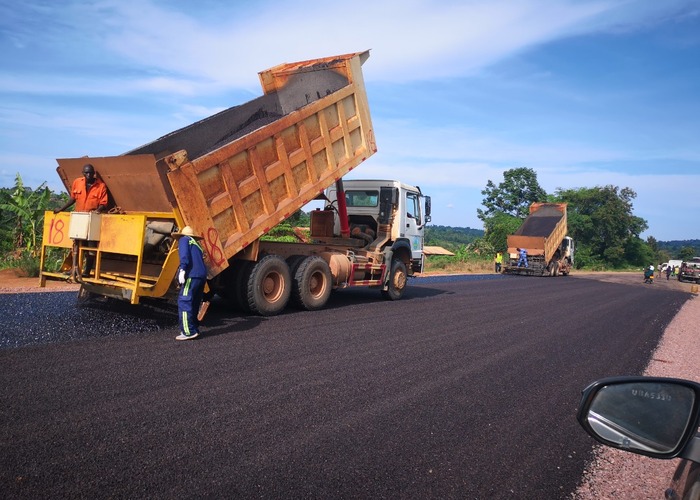
Construction workers along Kanoni-Kabulasoke section
Apparently, the number of taxis, operators, and passengers is gradually increasing. Kazungu and his counterparts in the business can make return trips before night fall.
Rose Namuleme, a regular road user from Kabulasoke town, still in Gomba, says the transport costs for one journey (Kabulasoke-Kampala) was sh20,000 initially and later cut to sh15,000.
"We now travel fast and conveniently at a relatively fair cost compared to what it used to be before the road project. For instance, from here (Kabulasoke) to Mpigi, a taxi can charge you around sh7,000 or sh6,000 if you bargain," she notes.
Richard Deogratius Lubega, a livestock transporter in Sembabule town, plies Sembabule- Maddu (Gomba), Sembabule-Masaka and sometimes Sembabule-Kampala depending on the transportation deal.
According to him, his truck used to break down due to overwhelming potholes, yet the repair costs were inconceivably high.
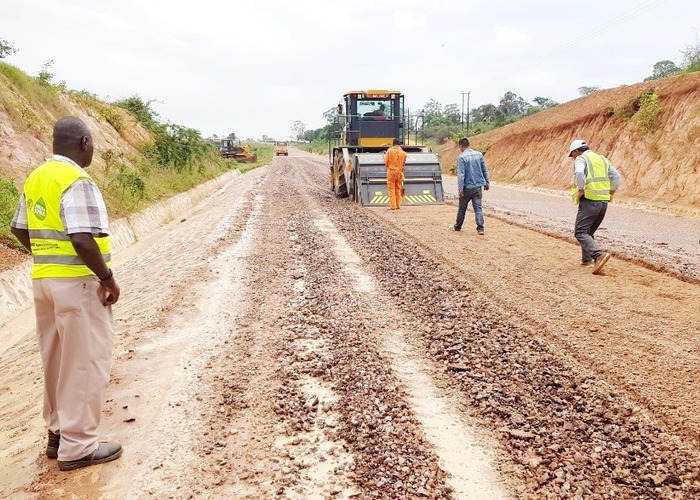
CR3 staff and other workers grading the Sembabule-Kanoni road
This is one reason he could hardly ever make regular trips to Maddu and beyond, unlike today when the road is in good shape and permits convenient haulage.
"If a car diff or the engine experience mechanical glitches, I would pay over sh400,000. Imagine if this happened over five times in a year, I would be too much for me," Lubega relates.
Bosco Bukenya, a produce transporter plying Sembabule-Masaka and Sembabule-Gomba- Kampala, says the new project has opened the route for small villages, trading centres, and towns to major highways, towns, and markets.
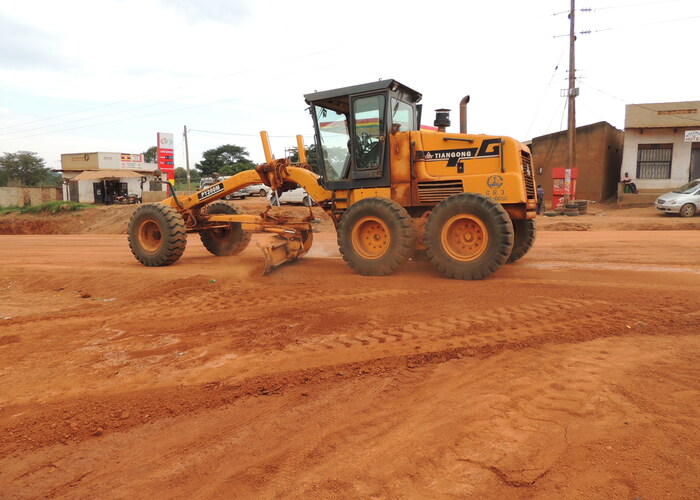
CR3EG grading one of a few sections yet to complete in Ssembabule
He explains that there were very few produce transporters plying the Mpiji-Gomba-Sembabule-Masaka route. A few that existed would charge farmers and dealers exorbitantly, yet the produces still delayed on the road as the trucks took long to maneuver the potholes and difficult sections.
"The road has attracted several transporters who had initially shunned it due to its state. They can easily access farms in small communities to collect produces and transport them to Kampala with ease and in time," he says.
Agricultural transformation
The majority of people in these districts depend on agriculture. ie growing crops, rearing livestock, trading and transporting animal products. They rely chiefly on roads to transport their produces and products to various markets and other destinations.
According to Dr. Emmanuel Kawooya Karungi, the Sembabule District Production Coordinator, the development of the agricultural sector dependents on improved road infrastructure.
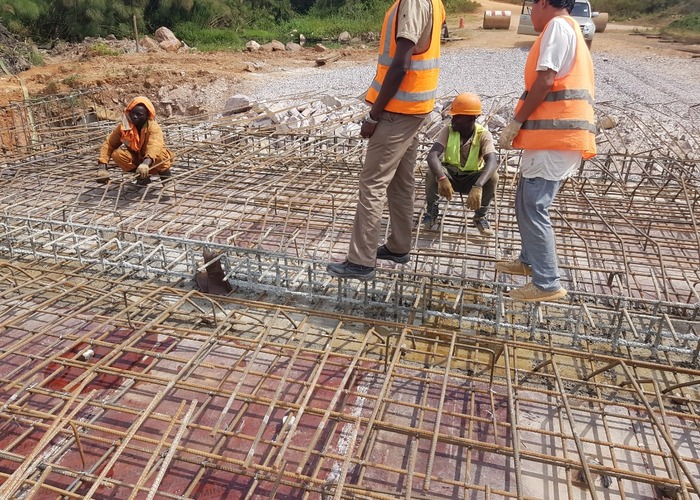
He says that substandard roads noticeably compel transaction costs of agricultural produce to go up. As a result, the price of agric-inputs tends to increase which affects production.
Karungi says multiple feeder roads have already connected to the highway easing access to livestock farms and plantations.
"We are now seeing more traders and trucks coming in Sembabule than never before. For example close to 500 trucks come in collect maize from Ntuusi and Lwemiyaga to take it to Kampala, Malaba, Mpigi, Masaka, Kyotera and Mutukula. In the meantime, 1kg is between 1,000 and 15,000 due to increasing traders," he says.
The improved road network and electricity have improved value addition whereby several milk coolers, coffee hullers, maize mills have opened.
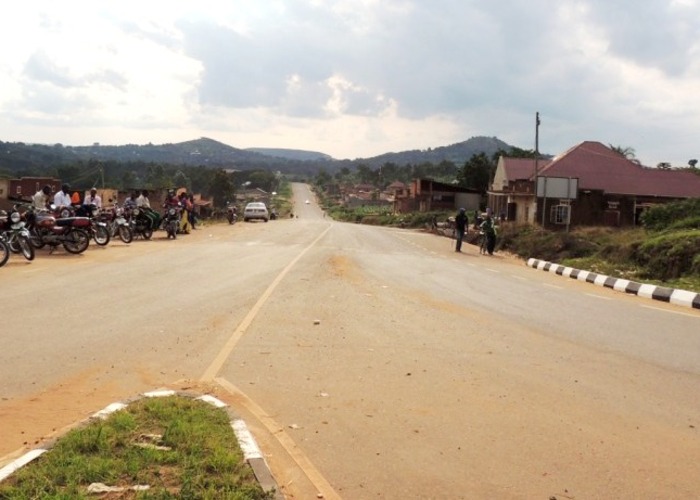
Kanoni- Maddu-Sembabule road
"About 4 years ago we had just 20 milk coolers of 5,000ltr capacity with a liter was going for shs700. But now, we have 40 milk coolers of 5000ltr and a litre costs shs1000," he explains adding that more transporters and dealers are still coming in due to accessible routes road network.
In terms of coffee, Karungi said the whole district had six coffee hullers but there are more than ten and the production has doubled, "At least from 100 metric tons to 1000 metric tons now".
Johnie (not Johnnie) Ssenabulya, the Maddu Sub-county Agricultural Officer, told us the road project is a blessing to the people of Maddu.
He says they had only eight stores of maize before and currently 25 due to increased production and easy transportation. "In 2015 we could only produce 200 metric tons of maize. But after traders and farmers increasing, we currently produce 8000 metric tons," he states.
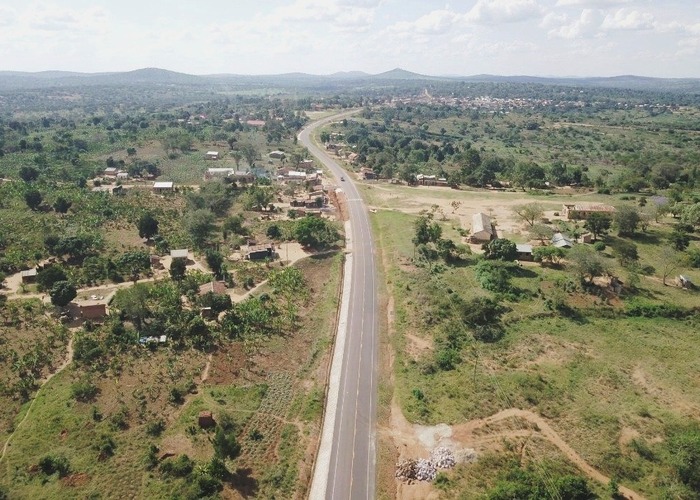
The new Sembabule-Villa maria highway snaking through different communities and towns
Even with such common challenges as climate change, pests and diseases, Ssenabulya says farmers and traders have the assurance that even the little yields will easily reach markets.
Morgan Aiden Kawalya, is a large-scale pumpkin grower in Kisozi A village, Kisozi Parish-Gomba district. He has over 15 acres of the crops with markets in Kampala, Masaka, Mpigi, Sembabule and Gomba mainly.
His production capacity had diminished due to the poor road condition which later affected his personal incomes. He recounts that he would sell the biggest pumpkin (5kgs) at shs1,500 or less at farm price.
"However, it is the new road and presence of transporters that inspired me to increase production, after being sure that I have access to major markets" he notes, adding that he currently sells the smallest size (half/1kg) at shs1,000 while the biggest (5kgs) goes for shs4000 and more which is quite an income.
As a result, several people along the entire road stretch have joined modern large-scale farming in addition to various income-generating ventures. They deal in coffee, banana, piggery, passion fruit, fishing, poultry, cabbages, livestock, and others.
"We just need a positive mindset of people in communities along the change and take farming as a business since the population in the country has increased. Let them use the road to transport produces to different markets because people have to eat every day," he says.
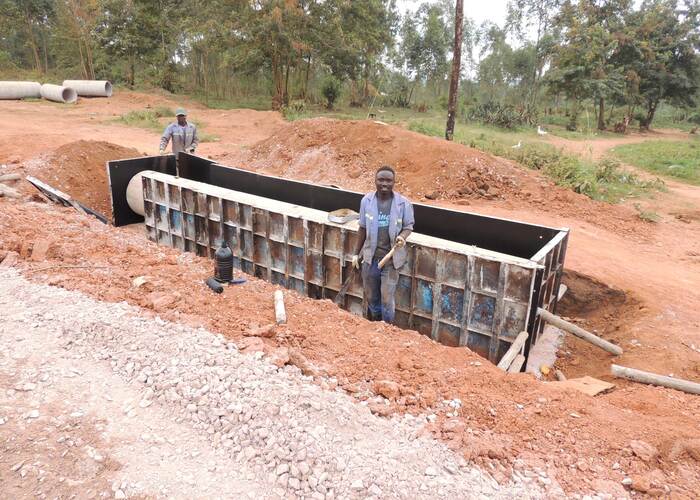
Some of the employees d constructing a drainage system along the Ssembabule -Masaka Road
Annet Baduuza and her husband Everest Kakooza are prominent banana farmers owning more than 15-acre-plantation in Kanoni town council. They are the founder members of Bajjaja Group having over 15 large-scale banana and coffee farmers.
They told us that they have embarked on land and agricultural expansion to supply the overwhelming demand for bananas in Gomba, Masaka, Sembabule and Kampala.
The couple had initially resorted to subsistence farming after their transporters and produce dealers from Mityana, and Kampala shunned the route to Kanoni which was in a sorry state.
"We embarked on agricultural expansion soon as road works kicked off. I and my husband harvest between 60 and 80 bunches every week. We acquired more land in 2018 for farming and we hope to increase yields from up to 120 and 130 bunches every week," Baduuza says.
Since they have their own truck, Kakooza explains that they are able to supply markets in Gomba, Gombe, Katwe, and Kampala. He adds that dozens of maize, and beans farmers are coming up to support food production in the region.
George William Kazibwe deals in large-scale banana farming on his 12 acre-portion in Kyagonza village -Kanoni town council.
He harvests over 80 bunches every week and supplies local residents and markets outside the town council, hotels and restaurants depending on the orders.
Gerald Byansi, the proprietor of Byansi Coffee Factory in Kanoni, attributes the increasing number of coffee farmers and factories to easy transportation and feeder road access to the new road.
In spite of the common coffee theft, Byansi processes between 13 and 14 tons of coffee compared to 8 tons before the road was upgraded. He further attributes it to increased demand and availability of transporters.
"The poor road affected every activity in the district. You could find three or four trucks transporting coffee from major coffee factories. But today, several trucks line up to load the coffee and take it to Kampala or Masaka," he adds.
According to Byansi, his saving propensity has increased because he minimised on the regular costs to fix trucks that would break down as a result of the bad road. "There's no month that passed without fixing trucks. I would spend a minimum of shs350,000," he states.

Trucks along Kanoni-Mpigi road
Other factors
However, much as the new highway has given progress to the agriculture sector, the farmers also argue that food prices have locally reduced to increased number of people joining farming.
Apart from the road infrastructure, there are other several factors to consider such as good and sustainable agricultural practices.
These include mulching, using cover crop, irrigation, agro-forestry, intercropping, mixed farming, integrated pest management (IPM), operation wealth creation, Integrating livestock and crops etc as well as.
Others are rural electrification, changing mindset about agriculture, access to markets and improved feeder roads.
Economic, Rural development
Vast investments, improved infrastructure (water, electricity) and growing population have stimulated development in town councils, trading centres and small towns along the highway.
Retail shops, bars and pubs, lodges and guest houses, rentals, milk diaries, restaurants, mobile money shops, gas stations have opened up plus small roadside stalls that have helped poor households to reduce the income inequality as well as benefit those who rely on the transportation sector.
According to Vicent Mugenyi (not Vincent), the Maddu LC3 Chairperson, they can now generate over one billion shillings (shs1b) from Maddu, Kigezi, and Kyayi cattle markets yet they open twice a month.
"We thank the government for the project and CR3 for the standard road works which have attracted different cattle dealers in Maddu. The revenue we get helps to run the town council activities," he notes.
Mugenyi further recounts at least ten trucks that take milk from Maddu everyday unlike in the past when about four would maneuver to Maddu to collect milk.
In the same way, Mugenyi says, commercial motorcyclists (locally bodaboda) have increased and eased transportation various trading centres.
In the health sector, he adds, patients can easily reach different health centres in time unlike in the past when a patient would find hard time finding quick means of transport and traveling on a dusty-bumpy road.
Everest Kakooza runs several agro-shops in Gomba supplying hybrid maize and vegetable seeds, farm tools such as hoes, hand pumps plus chemicals and sprays.
"Remember the state of the road back then could not attract road-side businesses due to dust. But after completion, I have managed to open up three other shops" he adds.
Maria Katana, a food vendor in Maddu trading centre, says food prices began falling from the time CR3 rolled out construction works in 2016. She attributes it to the growing number of farmers due to convenient transportation.
She adds they could buy a huge bunch of bananas between shs22,000 and shs25,000 in the past due to little production and impassable roads.
"But currently, one can get the same bunch at shs150,00 or shs13,000 and less when they flood the local market. It is a blessing to us much as the farmers feel the pinch," she explains.
UNRA Hails CR3
The Uganda National Roads Authority has lauded CR3 for the efficient construction of the Kanoni-Sembabule-Villa Maria road project.
CR3 is a China state owned company and one of the biggest construction enterprises in the world. The company has successfully undertaken multibillion construction projects in more than 10 foreign countries including Uganda, Tanzania, Ethiopia, Nigeria, Singapore, India, UAE to name a few.
Mark Ssali, the UNRA Communications Officer, explains that although there have been some delays due to unavoidable circumstances; the project is expected to be completed on 1st October 2019.
"UNRA has been supervising the contractor (CR3) for the start and we can confirm that the Contractor has followed the Contract Specifications and items in the BOQ to ensure the designed lifespan of the road of 15 years," he says.
In his explanation, several contracts have eligibility criteria and procurement standards which UNRA relied on award CR3G. He adds that it is the same procedure to determine whether the contractor is eligible or not.
According to Ssali, the project has improved the livelihood of the communities along the road by reducing travel time and cost, hence boosting economic activity. He adds that access to social services like schools, markets, trading centres and hospitals has also been boosted too.
CR3 has also handled other projects include Hoima-Katungulu road and Soroti- Moroto road which are both of good quality and standard.
While commissioning the road at Kitaasa in Bukomansimbi in 2015, President Yoweri Museveni urged residents to support the government plan to heavily invest in long-lasting public goods such as electricity and roads.
He further appealed to residents to utilise the road project for economic transformation and development of the country.
Project manager
Li Peng, the Project Manager/Site Agent, told New Vision that the experience gained from the past projects has enabled them to gain confidence in constructing standard road projects.
According to Peng, their camp at Kawanda village in Sembabule has so far recruited over 3000 skilled and unskilled workers with twenty percent being female.
The professional slots included Laboratory technicians who test the quality of material used, surveyors, safety officer, quality control, accountants, communication officers, engineers and departmental managers.
Others are drivers, cleaners, cooks and carpenters. "We had to ensure that jobs mainly cleaners, cooks are reserved for only women for gender sensitivity," he explains.
The challenges highlighted in the project include delayed payment from UNRA. He says they never received payment from last October 2018 until April 2019 which forced them to get financial support from the government of China to proceed with the project.
Currently, there's a pending challenge of the Project Affected Persons (PAPs) in Sembabule who refused to vacate even after signing agreements and receiving their compensation. They later changed their mind and asked for more money which interfered the construction project.
"We have consistently engaged UNRA to resolve the matter for over a year now but nothing has been reached yet as contractors we have nothing to do about it," he states.
If the UNRA fails to resolve the matter, Penge says, they will be left no option but to hand over the project with the remaining portions undone.
Peng explains that at one point UNRA changed the road design which caused delays plus a financial and material loss to the company.
"We had to get more financial support from Beijing not to delay the project. We also transferred technical and material support from our Moroto-Soroti project.
In his explanation, CR3 deserves more projects in Uganda due to the quality of work and political backing of the Chinese government. This, he says, will strengthen the relationship between the two countries and create more jobs in Uganda.
The Company's SCR
Nevertheless, the challenges did not stop CR3 from doing some Social Cooperate Responsibility in Gomba and Sembabule. The company has leveled several school pitches and church grounds.
Road maintenance
With a sustainable road maintenance system upheld, taxpayers, political leaders, civil society, residents and regular road users believe the road standard will produce short and long-term benefits in terms of lower transport costs plus swift and easy access of goods and services.
They have appealed to the government to always involve them during the planning process of such public goods.
Note: This article was produced under the support of a grant by the Africa-China Reporting Project managed by the Journalism Department of the University of Witwatersrand.